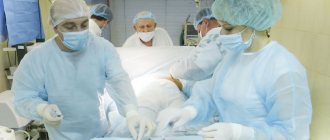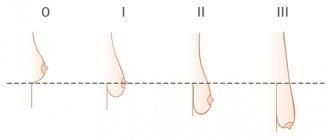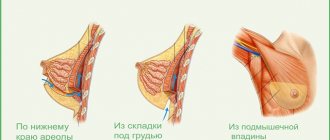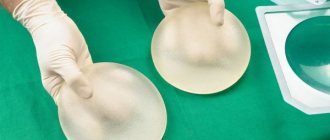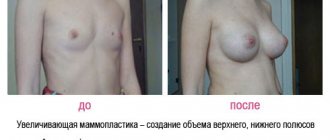Mastopexy is a breast lift. Currently, plastic surgery, and especially the area of breast surgery, is one of the most rapidly developing areas in Krasnodar. One of the most popular breast plastic surgeries for women today is mastopexy. The purpose of this operation is to give the mammary glands an optimal size and shape.
Breast drooping (ptosis) is a natural process that affects a woman’s breasts throughout her life. Loss of shape occurs especially quickly after pregnancy, breastfeeding or significant weight loss. Sometimes the shape of the mammary glands is associated with hereditary factors, which often affect only one breast and lead to asymmetry. It is customary to speak of the presence of ptosis of the mammary gland in cases where the level of the nipple falls below the level of the inframammary fold. In this case, with normal or slightly reduced breast volume, a breast lift (mastopexy) can be performed. Today, breast lift in Krasnodar is the most relevant area of plastic surgery.
In what cases is a breast lift performed?
Breast prolapse is the only indication for mastopexy. Breast surgery is very often performed on women who have carried and breastfed a child, but there are other reasons for the appearance of ptosis:
- influence of gravity,
- hormonal effects on glandular tissue,
- fluctuations in a woman's body weight,
- loss of elasticity of the skin and gland tissue.
Breast lift is performed only for aesthetic reasons and is the most current area of plastic surgery.
Vertical breast lift
For mild breast sagging, a vertical breast lift is performed, which involves making an incision around the areola and down to the inframammary fold. During the operation, it is also possible to reduce the areola, after which the nipple-areolar complex is fixed in a new position. The breast tissue is also tightened and fixed, after which a suture is applied.
Anchor breast lift
Breast lifting using this method is optimal for grade 3-4 breast sagging; it allows you to achieve a lasting and aesthetic result at any degree of complexity. This breast lift technique allows you to remove a significant amount of skin, but otherwise the operation is carried out according to the same procedure.
Periareolar breast lift (circular breast lift)
Used only in the initial stage of ptosis. The incision is made around the areola, after which excess skin is removed and the wound is sutured. A periareolar breast lift is often combined with the installation of implants, where breast augmentation and breast lift occur simultaneously. This operation is low-traumatic and does not leave noticeable scars.
Breast lift - eliminating sagging and correcting shape
Sagging breasts are a fairly common problem. If the nipples fall below the inframammary fold, then we can already talk about the available indications for breast lift surgery.
In very general terms, ptosis correction involves removing excess skin and moving the nipple and areola above the inframammary fold line. The shape and size of postoperative sutures depends on the method chosen by the doctor.
The result of mastopexy is quite stable. However, it is possible for the breasts to sag again. There are few reasons for this unpleasant phenomenon. The most common reason is a change in the patient's weight. Even a few kilograms lost can significantly affect the outcome of breast lift surgery.
If the repeated deformation is insignificant, then surgical intervention can be quite simple. In case of serious changes, only a full-fledged repeated plastic surgery to correct the shape of the mammary glands can help.
Breast lift. Indications for surgery
- Breast ptosis caused by pregnancy
- Breast ptosis due to breastfeeding
- Breast ptosis as a result of sudden weight loss
- Hormonal effects on gland tissue
- Age-related decrease in the elasticity of the skin and breast tissue;
One of the signs indicating the need for mastopexy is the location of the nipple relative to the inframammary fold. If it drops below the level of the fold under the breast, the operation is permitted.
Breast lift. Contraindications for surgery
- Minority
- Infectious diseases
- Oncological diseases
- Diabetes
- Bleeding disorder
- Inflammatory skin diseases
- Pregnancy and breastfeeding period
Preparing for surgery
If you are planning a breast lift, you should first consult with the plastic surgeon who performs this procedure. Find out from the doctor about the nuances of future correction that interest you, asking him all your questions.
If you cannot meet with a surgeon, we draw your attention to the Online Consultation service. Ask any question about breast lift and receive an answer from the surgeon within one business day.
No less mandatory conditions for a breast lift are undergoing a routine medical examination and testing.
Progress of the operation
During breast lift surgery, the surgeon makes an incision in the breast area and redistributes the volume of the mammary gland so that the nipple and areola take the desired, higher position. This is followed by excision of excess skin in the affected area and suturing. Mastopexy does not affect the size of the bust, but the shape does - it noticeably improves.
Several methods are used for breast lift. For each patient, the surgeon selects the method of breast lift that best suits her individual characteristics . The choice of type of correction depends on the degree of deformation of the shape of the mammary glands.
In the case of a slight degree of ptosis of the mammary glands, a periareolar breast lift is performed, which is characterized by an incision only along the circumference line of the areola. The weakness of this method is that the bust acquires a flatter shape after surgery. It is for this reason that periareolar mastopexy is indicated for patients with an axially elongated breast shape.
Breast lift with a T-shaped suture is no less a technique used today. During the intervention, incisions are made not only around the areola, but also vertically (from the nipple to the inframammary fold in the center of the breast) and horizontally (along the fold line under the breast). The disadvantage of this method is the significant total length of the seams.
Mastopexy using a vertical technique is by far the most popular breast lift technique. The incision is made along the circumference of the areola and from the nipple to the fold under the breast. The advantages of using this technique are obvious: the operation is faster, nipple sensitivity is preserved, the mammary glands are not just tightened, but take on the most natural appearance, and the likelihood of postoperative complications is reduced.
Rehabilitation after breast lift
During the month it is forbidden to resort to intense physical activity. At this time, you will have to “forget” about visiting the gym, bathhouse, sauna. It is necessary to wear compression garments around the clock for a month from the date of surgery. After mastopexy, unlike breast augmentation, pain is insignificant. The stitches are removed within 10-14 days. Postoperative scars will fade no earlier than 0.5-1 year after surgery.
It is important to understand that any marks on the chest will remain after correction. At the same time, their visibility can be minimized using laser resurfacing and special injections.
Cost of the operation
The price of a breast lift depends on the complexity of the surgery. The cost of the operation is also affected by the number of days spent in the hospital and the cost of implants. The full cost of the operation is determined by the surgeon at a preliminary consultation, when he gets to know you better and conducts an examination.
___
Initial appointment with a plastic surgeon - 1,000 rubles.
Carrying out the operation - from 85,000 rubles.
Other expenses - find out the full receipt of the all-inclusive operation from the clinic administrators by phone. 8 (863) 2-372-000
Endoscopic breast lift
Endoscopic breast lift is possible only if ptosis is eliminated by installing implants, when the endoprosthesis fills the empty space.
There are a number of contraindications to this procedure:
- the presence of tumors in the mammary glands;
- venereal diseases;
- less than 12 months after lactation;
- diabetes;
- disturbance in the circulatory system (poor blood clotting);
- diseases of the patient’s internal organs that occur in severe form;
- mastopathy.
Rehabilitation after breast lift
The doctor applies a bandage immediately after the operation; it allows you to form the correct shape of the breast. On the 2-3rd day, the bandage is replaced with a special bra to securely fix the breasts in a new position; drainage tubes are removed. On the first day after surgery, slight pain may occur. The stitches are removed in stages, the last ones no later than 2 weeks. Swelling and bruising disappear within 3 weeks. The scars remain red and quite noticeable for many months. The shape of the breast may change for several weeks after surgery due to decreased swelling and slight drooping of the breast during the healing period. At this time, the breasts take on a more natural shape. The final result can be observed only after a year
Features of mastopexy
Mammoplasty and breast lift require general anesthesia, so the patient does not feel anything during surgical procedures. The whole process takes 2–3 hours. There are various techniques for lifting the mammary glands; which one to use in a particular case is decided by the doctor after consultation. Depending on the chosen technique, the incisions are located:
- around the areolas;
- vertically down from the areolas;
- horizontally along the contour of the mammary glands.
We use self-absorbing sutures that do not need to be removed.
Breast lift - indications for surgery
The most common indication for this surgical intervention is ptosis, a condition in which the mammary gland descends to such an extent that the inframammary fold is higher than the areola. The reasons for this phenomenon are varied. For example, it is often observed in women who have given birth as a result of breastfeeding. This is due to the fact that during lactation the hormonal levels change, and the volume of the breast increases - the skin stretches. The ligaments that support the mammary gland are also subject to stretching, and at the end of the period of breastfeeding, when the glands are reduced to their original volume, they may sag. Sudden weight loss also leads to ptosis. Age-related changes can also cause sagging breasts. But whatever the cause of ptosis, it can only be eliminated through surgery.
There are three degrees of breast ptosis:
- With grade I ptosis (minimal), the inframammary fold is at the same level as the nipple.
- Moderate ptosis (II degree) corresponds to the position of the nipple higher than the lower pole, but 1-3 cm below the fold.
- In the case of severe ptosis, when we are talking about the third degree, the nipple is located in the area of the lower pole, in its deepest part, and the breast moves 3 or more centimeters below the inframammary fold.
Glandular ptosis and pseudoptosis are also distinguished. In both cases, hyperplasia of the glandular tissue occurs, as a result of which it is located under the submammary fold, and the nipple is located just above the fold (pseudoptosis) or at the same level with it (with glandular ptosis).
Drooping mammary glands are a fairly common, but not the only indication for mastopexy; it also helps eliminate other shape abnormalities:
- stretching that is not accompanied by nipple drooping;
- asymmetry of the right and left breasts;
- violation of contours;
- hypoplasia - abnormal development of the left or right breast;
- drooping lower parts.
In all of these cases, special gymnastics will not give any effect. Following a diet will not help you get back into shape. Special creams and ointments will also have no effect. The only thing that can help is mastopexy. The effectiveness of this surgical operation has been proven many times in practice. As a result, the breast shape becomes more beautiful and the skin becomes elastic.
Mastopexy at the clinic "Tkach Oleg Sergeevich"
Performing mastopexy at the Oleg Sergeevich Tkach clinic includes the following steps:
- preliminary examination by a surgeon;
- examination;
- determination of the methodology required in this case;
- direct execution of the operation;
- observation in a hospital setting;
- subsequent rehabilitation.
The duration of the medical examination varies from one to three hours. It includes a mammogram as well as several clinical tests. Taking into account the medical history, other examinations may be prescribed. During surgery, local anesthesia is used, combined with drugs that have a sedative effect. In some cases, general anesthesia may be used, depending on the technique used.
The operation lasts from two to three hours, after which observation in a hospital is required for one to two days. After one or two weeks, you need to visit the clinic to have the stitches removed; the exact period is determined by the doctor; in some cases, the stitches do not need to be removed (they are self-absorbing). Swelling, hematomas, bruises, decreased sensitivity or mild soreness may be observed, but within a few weeks these unpleasant phenomena will disappear.
Contraindications to mastopexy
This operation should not be performed on people who are under 18 years of age, planning a pregnancy in the near future, or who have recently completed breastfeeding. There are other contraindications:
- diseases of the autoimmune type, as well as cancer;
- thyroid dysfunction;
- various infections;
- hemophilia and other diseases that affect blood clotting;
- a number of skin diseases;
- pathologies of blood vessels and hematopoietic organs;
- a number of skin diseases;
- heart failure, as well as kidney failure, which has reached the level of decompensation;
- hypertension;
- high degree of obesity;
- mental disorders.
The operation should be preceded by a comprehensive examination, based on the results of which the surgeon decides how appropriate it is to perform mastopexy in this case. If the decision to operate is made, the specialist determines the technique for performing the future operation. In some cases, mastopexy can be combined with the installation of endoprostheses (implants).
Rehabilitation period and effect of breast lift surgery
The formation of mammary glands after surgery lasts from three to six months. The formation of scars takes from six months to a year, after which they become almost invisible. During the recovery period, you should use compression garments for one to two months.
The effect of mastopexy lasts for a long time, but subsequent pregnancy or sudden weight loss can lead to prolapse again. Complications are extremely rare, but they still occur in some patients. These include infections, prolonged healing, and undesirable changes in breast contour or asymmetry. Any symptoms that cause concern should be reported to your doctor immediately.
At the Oleg Sergeevich Tkach clinic, operations aimed at changing the shape of the breast and lifting it are performed by a highly qualified surgeon with solid experience. The use of the most advanced methods minimizes the risk of complications, guarantees a painless and safe operation and a quick recovery after it with minimal consequences. Mastopexy, performed at the Oleg Sergeevich Tkach clinic, will help restore the shape of your breasts and again feel your attractiveness at any age.
Rehabilitation after mammoplasty
- Immediately after the intervention, tissue swelling and some pain may be observed - these unpleasant sensations will pass within 2-4 weeks.
- Loss of sensation in the operated area may last longer - up to six months. After this time has passed, sensitivity will begin to gradually return.
- In the first two weeks, avoid physical activity, including intimacy. It is better to sleep on your back or side - so as not to put pressure on the mammary glands.
- During rehabilitation you will have to wear special supportive underwear. How long - the surgeon will tell you during an individual consultation after the operation.
